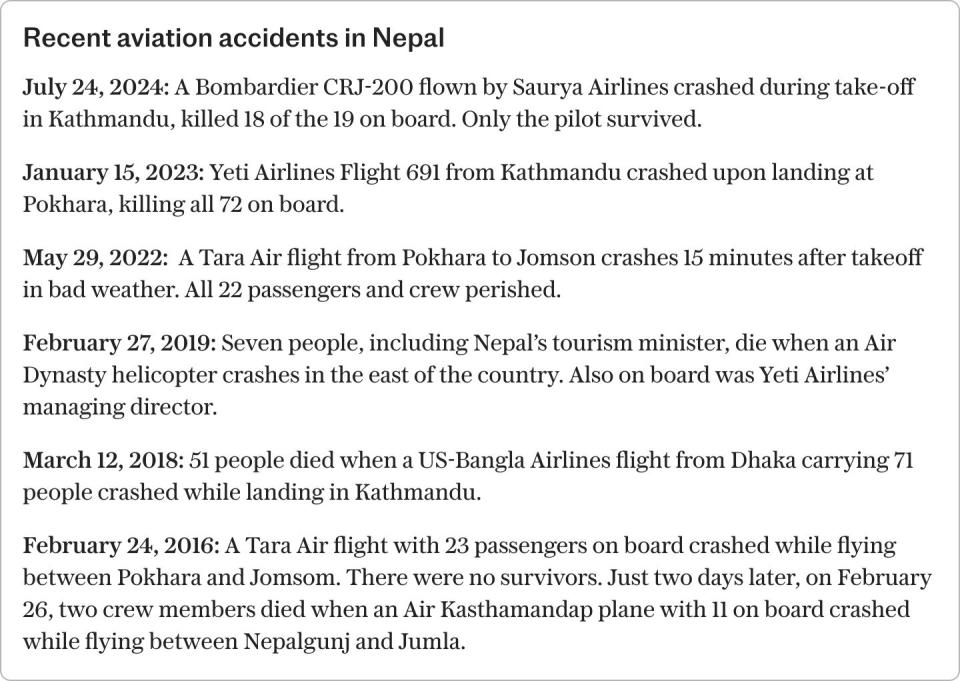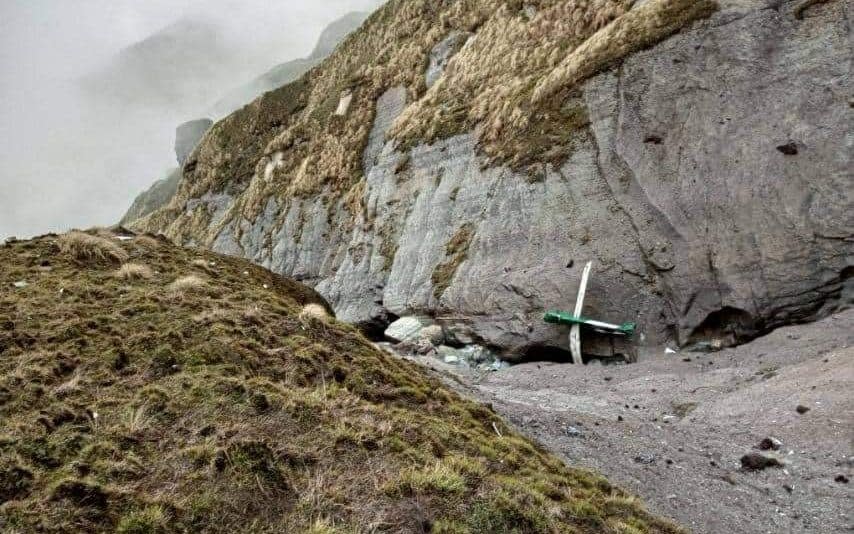At least 18 people have died after a small plane crashed and caught fire on takeoff from the Nepalese capital Kathmandu.
According to Dan Bahadur Karki, a spokesman for the Nepalese police, the Saurya Airlines plane was carrying two crew members and 17 company employees.
The crash raises new concerns about the safety of Nepalese airspace. Since the turn of the century, the country has seen 19 fatal air crashes, killing 359 people. Today’s accident follows the January 2023 crash of Yeti Airlines Flight 691, the deadliest in Nepal in 30 years.
Since 2013, all Nepalese airlines have been banned from flying in European airspace due to their poor safety record. While aviation regulators have noted some improvement in recent years, they say problems remain.
In this article, we discuss why Nepal is still one of the world’s most dangerous flight destinations, and what passengers who want to travel there can do to minimize their risks.
What caused the last crash?
The cause of the latest crash is still unclear, but more details are likely to emerge in the coming days.
The plane crashed around 11:15 a.m. (05:30 GMT), the Nepalese military said in a statement. News site Khabarhub reported that the plane caught fire after skidding on the runway.
The plane was scheduled to fly on Nepal’s busiest air route between Kathmandu and Pokhara, a major tourist hub in the Himalayan republic. Saurya Airlines operates exclusively Bombardier CRJ200s, its website says. The crash has left the company with just one plane in its fleet.
Do Nepal have more accidents than other countries?
Yes. The crash is the 12th fatal plane crash in Nepal in as many years, a remarkable statistic given the relatively modest flight schedule.
While there is no definitive global benchmark for aviation safety by country, Nepal is one of the most dangerous flying destinations in the world according to most statistics.
As mentioned above, Nepalese airlines have been banned from flying in European airspace since 2013 due to their poor safety record.
A 2022 aviation safety audit by the International Civil Aviation Organization (ICAO) found that the level of implementation of certain elements of safety management in Nepal was below the global average.
According to AirlineRatings.com, Nepal Airlines ranks among the 14 best airlines for safety, with just one star, alongside airlines from Iran and Suriname.

What are the causes of the poor security situation in Nepal?
A combination of factors has led to Nepal’s troubling record. AirlineRatings.com editor-in-chief Geoffrey Thomas cites three main reasons, including “treacherous flying conditions in and around the Himalayas,” sometimes “substandard pilot training and therefore skills,” plus “poor and dangerous airports that are often below world standards due to the mountainous terrain.”
The country is home to many of the world’s tallest mountains, making it particularly dangerous for pilots, who must navigate both the peaks and the rapidly changing weather. In 2015, the United Nations’ International Civil Aviation Organization prioritized the country for technical assistance, stating subsequently that its “beautiful but rugged terrain makes safe air operations more challenging than in other parts of the world.”
Mountainous airports tend to have shorter runways, which require greater pilot skill and can only accommodate smaller, sometimes less reliable aircraft. Nepal’s Lukla Airport, the gateway to the Everest region, has previously been named the world’s most dangerous, an unwelcome but not surprising title given the number of accidents. The airport’s runway is just 1,729 feet long (Heathrow’s shortest is 12,008 feet) and ends abruptly at a brick wall. With mountains rising all around, there’s little chance of an aborted landing, so pilots have to get it right the first time. The airport’s altitude also means the air is thinner, so planes have no choice but to arrive more quickly.
Given that Nepal remains one of the poorest countries in Asia, it’s no surprise that some of its airlines have aging fleets and that its pilot training programs can’t compete with those of Western nations. Industry insiders have noted that some of the older planes don’t even have GPS systems. Yet according to the website Planespotters.net, the Saurya Airlines Bombardier CRJ200 plane involved in the most recent crash (registration number 9N-AME) was 21 years old — a fairly normal age for a commercial aircraft. The Yeti Airlines plane involved in the 2023 crash was just 15 years old.
Some argue that Nepali authorities could do more to improve air safety. After a 2022 crash involving Tara Air, Ashok Pokharel, president of the Nepal Association of Tour Operators, told the Guardian: “The older planes don’t have modern weather radars. That could be made mandatory so that the captain has real-time weather information for where he’s flying.”


What can travelers do to reduce their risks?
Those planning to climb Everest or undertake other treks in the Himalayas may be wary of booking domestic flights within the country. Given the poor condition of the roads, such flights are difficult to avoid.
The FCDO’s travel advice page for Nepal states: “Air crashes can have a variety of causes and are not necessarily linked to poor safety standards or failure to adhere to international safety standards. However, there have been a number of fatal crashes and air accidents in Nepal in the commercial aviation sector (airplanes and helicopters). In the past five years, this includes a number of isolated incidents and at least 100 fatalities.
It adds: “The UK Air Safety List (ASL) lists all known airlines in Nepal that do not meet international safety standards and are banned from operating commercial flights to or from the UK. Check the UK Air Safety List when considering flying and which airlines you wish to fly with. The list is maintained by the Department for Transport, based on advice from the UK Civil Aviation Authority.
“Currently, no Nepalese airline meets international safety standards and therefore they are all on the ASL. This means that they are all banned from operating commercial flights to or from the UK.”
Ultimately, tourists who travel may simply need to assess their own risk tolerance. As Geoffrey Thomas puts it, “For travelers and adventure tourists, there is little choice. Everest is dangerous to climb, and so is flying there.”
This article was first published in January 2023 and has been revised and updated.